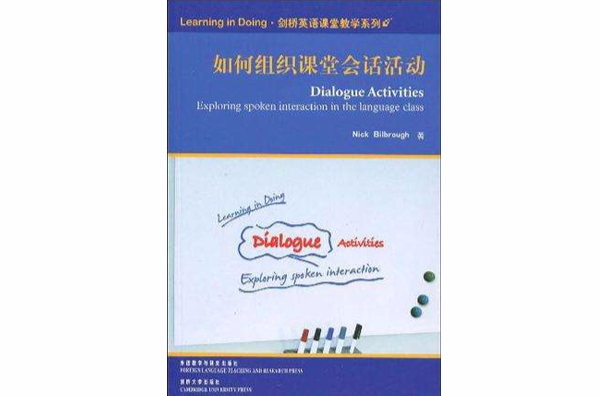《如何組織課堂會話活動》是2009年9月外語教學與研究出版社 , 劍橋大學出版社出版的圖書,作者是比爾伯勒。
基本介紹
- 書名:如何組織課堂會話活動
- 作者:比爾伯勒
- ISBN:9787560089553
- 頁數:244
- 定價:33.00元
- 出版社:外語教學與研究出版社 , 劍橋大學出版社
- 出版時間:2009-9
- 叢書: 劍橋英語課堂教學系列
圖書簡介
圖書目錄
Introduction
1 Understanding
1.1 Understanding dialogues:a basic procedure
1.2 Board grab
1.3 Reading versus listening
1.4 Dialogue interpretation worksheets
1.5 Jigsaw
1.6 Designing exam questions
1.7 What are they talking about?
1.8 Snippets
1.9 Fairy tale tableaux
1.10 Lame jokes
1.11 Working with interviews
1.12 Dialogue as a way into a graded reader
1.13 ThebitIlike
2 Analysing
2.1 Tricky words
2.2 Closed mouth minimal pairs
2.3 Fishermen
2.4 Stage directions
2.5 Authentic versus scripted dialogues
2.6 Dialogue scan race
2.7 Filling in
2.8 Speech acts
2.9 The teacher does the speaking test
2.10 Student dialogue reformulation
2.11 Backchannelling
3 Reproducing and reconstructing
3.1 Jumbled lines
3.2 Dialogue rebuilding
3.3 The ultimate gapfill
3.4 Listen again
3.5 Jumbled reconstruction
3.6 Dialogue pairs
3.7 Dialogue retranslation
3.8 Retranslated tapescript
3.9 Dubbing
3.10 From monologue tO dialogue
3.11 Turning news items into dialogue
3.12 Shadow dialogues
3.13 Mimed dialogues
3.14 Modernised voiceovers
3.15 Roughing up and censoring
4 Memorising
4.1 Who said what?
4.2 Reduced dialogues
4.3 Story tO dialogue
4.4 Adjacency pair turnover cards
4.5 Remembering the questions
4.6 Dialogue halves
4.7 Line byIine
4.8 Prompts
5 Rehearsing and performing
5.1 Chanted dialogue
5.2 Sounding like a gringo!
5.3 Itsnotwhatyou say
5.4 Students perform the listening material
5.5 Improvising into a scene
5.6 Shadowing actors
5.7 Dialogues with movement
5.8 Whos next?
5.9 Conducted dialogue
5.10 Performance to writng
5.11 Readers theatre
5.12 Direct speech
5.13 No wayJose
5.14 Lets have a drink
6 Co-constructing
6.1 By name and by nature
6.2 Halfaconversation
6.3 Dialogue building
6.4 Community language learning
6.5 Writing dialogue articles
6.6 Famous last words
6.7 Dialogue into song
6.8 Conversational involvement
7 Creating and personalising
7.1 What did we have to say?
7.2 The words Id like to own
7.3 Dice dialogues
7.4 Speech bubbles
7.5 Picture dialogues
7.6 Dark secret scenes
7.7 Soundtracks
7.8 Conscience alley
7.9 From depiction to dialogue
7.10 Semi-plannedrole-play
7.11 The room talks back
7.12 Into the future
8 Communicating
8.1 Venn diagrams
8.2 Speed dating
8.3 Gibberish scenes
8.4 Dialoguewarm-ups
8.5 The status game
8.6 Cline debates
8.7 Gossip
8.8 Paper talk
8.9 Multi-speakdialogues
8.10 ABC dialogues
8.11 Odds versus evens
8.12 The yes/no game
8.13 Robinson Crusoe Island
8.14 Whos lying?
8.15 Interclasscalls
8.16 Celebrity ball
8.17 Boring short stories
8.18 Read, turn and talk
9 Dialogue as learning
9.1 The closed question restaurant
9.2 Building a life
9.3 The dating agency
9.4 Talk and chalk
9.5 Never-ending dialogue
9.6 Would you give your teacher a job?
9.7 The tourists are coming
9.8 Dialogic text building
9.9 Cooperative storymaking
9.10 Teacher in role
9.11 Interrupting the tapescript
9.12 Dialogue versus internet
9.13 Difficult dialogues
Dialogue Bank A:From the film Mulholland Drive by David Lynch
Dialogue Bank B:Authentic snippets
Dialogue Bank C:Snippets from fairy tales
Dialogue Bank D:25 Lame jokes
Dialogue Bank E:Situationaldialogues
Dialogue Bank F:Dating Agency (from the comedy series Little Britain)
Further reading and resources
Index

